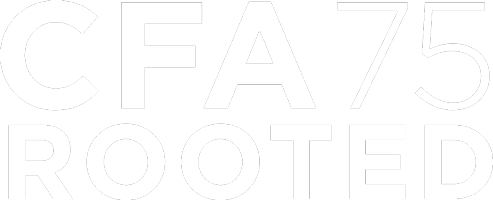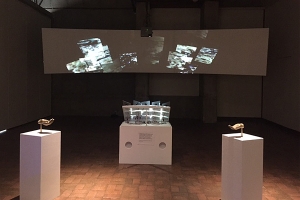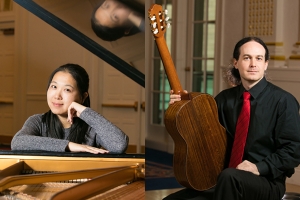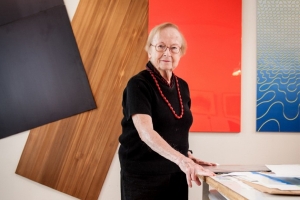Displaying items by tag: Art
By Emerging Leaders Ambassador and Guest Writer Rachel Luebbert
From February 2nd-17th the Gittins Gallery featured a collaborative exhibition organized by Assistant Professor in Sculpture Intermedia, Wendy Wisher, and Associate Professor in Computer Science, Erik Brunvand. This exhibition brought together six researchers from different departments at the University of Utah surrounding the discussion of the significance of water in the Western US.
The spirit of this exhibition was inspired by a collaboration that occurred 50 years ago. In 1966, Bell Laboratories funded 10 artists, dancers, musicians, and engineers for “9 Evenings: Theatre and Engineer” in New York. This marked the first large-scale collaboration between artists and engineers. Similarly, Liquid Collaboration serves as a collaborative anniversary and highlights an effort to foster new relationships.
The goal of Wendy Wisher and Erik Brunvard was to create an installation that was truly collaborative, unlike other projects that have just hired another partner to do the coding. Wisher explained, “We made a piece that is at first glance an installation that presents visual and audio components about water. But in a deeper way, it’s about how people need to come together and collaborate to solve these large and complex problems.” In their installation, Collective Currents, viewers came together and collaborated within the exhibition. Bronze casts of hands mark each side of the installation and viewers had to physically create a human chain, a sort of circuit. This physical collaboration caused the distant, garbled water sounds to become the babbling of fast flowing water, while the video fragments began to connect together to create a comprehensible video picture. The water depicted transitions from oily blackness to an imperfect cleanness. Wisher described this symbolism, “When we try to restore our water, it will never go back to its initial state and it cannot fully be returned to perfection.” However, through such collaborative work, we can come together to ensure that we have access to clean water.
In the piece Casual Nexus, Artist Tatiana Larsen and Computer Scientist Peter Jensen created a large suspended sculpture, which consists of a large, central, transparent sphere connected to six smaller spheres. The water level constantly changed responding to the number of people in the gallery as well as their distance to the piece. This installation inspired conversations regarding how draining water from one water source can affect other water sources negatively.
The third and final work, Words are Water is a multimedia installation with Tim Grant’s audio and Justin Watson’s visuals. The video is built on purely sonic and visual experiences connected to water— the viewer then constructed their own narrative without any specific voiceover or text. This installation uses drinking water and audio sourced from glaciers to discuss the mutually destructive effect of not preserving water.
Liquid Collaboration raised important environmental questions and challenged viewers to recognize their own role in the matter of Water in the West.
*Liquid Collaboration was funded by URC and the College of Fine Arts
Our creative community here at the College of Fine Arts is diverse and wide spread. With the goal of gaining a deeper knowledge and awareness of the people within our community, we bring you MAGNIFYING, a series dedicated to showcasing the talent of our students, faculty, and staff.
MAGNIFYING Interview #1: Steven Rasmussen, School of Dance
Tell us about yourself: Name, where you are from, what you do and how you got into in your field of work?
My name is Steve Rasmussen, I have lived in California, Michigan, Massachusetts, Montreal, Georgia, New York, Italy, Spain, and Utah. I am an Professor/Lecturer, Costume Shop Director, at the School of Dance, U of U. I started out as a painter, then started leaving the canvas blank and sewing it into shapes.
What has surprised you the most in your life?
What has surprised me is that I’ve been able to make just enough money to be able to travel to many places in the world. I never thought I’d be that fortunate.
What do you wish you had known, been told?
I wish I would have been told to GET OUT THERE AND BE BRAVE at a much younger age. As Joseph Campbell says: Follow your bliss.
Fifteen College of Fine Arts students are among the U’s most articulate ambassadors, without ever saying a word. School of Music students in the Red Hots! program perform for events all over campus, sharing their talents and love of music and transforming the ordinary into something special. Their appearance ensures that the arts have a presence at the University’s most important events.
As Jacqueline Voland of the School of Medicine explains, they are “the hidden gem on campus.” In its fourth year, the School established the Red Hots! to provide freelance experience for its students, while exposing the campus community to its exceptional musical talent. With a string quartet, jazz ensemble, pianists, harpists and classical guitarist, plenty of options exist for those wanting to create just the right ambience for their event.
The University President’s Office is a frequent requestor of Red Hot! Performers. “They bring high caliber talent, class and elegance to any event and leave a wonderful first and lasting impression,” explains President David and Dr. Sandi Pershing.
The student Red Hots! gain professional experience and strengthen their resumes by serving as University ambassadors to alumni, donors and the community. They also receive payment for every performance, providing support similar to a fellowship.
“The Red Hots! offers me opportunities to perform for varied audiences and to move people by my music,” said pianist and Red Hot! Shanmo Guan. The School of Music’s Advisory Board funds the Red Hots! program through its annual Camerata Awards Gala. Events that qualify pay no charge for Red Hot! Performers.
For more information please visit Red Hots!.
Artist Highlight: Anna Campbell Bliss
By Guest Writer and MFA Student, Allison Pinegar
Anna Campbell Bliss is just one of the artists who will be featured in the all-female exhibition in the UMFA’s Contemporary and Modern gallery when it reopens on August 26, 2017. In preparation for the all-female show, The Finer Points will be highlighting female artists from the UMFA’s collection, the state of Utah, and the University of Utah.
The work of Anna Campbell Bliss is organized and structural, yet organic and experimental. The first thing that typically hits the viewer when confronted with Bliss’ work is the extraordinary use of color. A student of the Bauhaus greats like Walter Gropius of Harvard and Josef Albers of Black Mountain College, Bliss developed a unique way of integrating color theory with architecture and technology. While her style is difficult to define, one common theme throughout her career is intersectionality. Bliss’ works combine form, pattern, structure, color, texture, science, mathematics, nature, dance, and poetry.
Bliss moved to Salt Lake City with her husband Robert when he accepted a teaching position in the School of Architecture at the University of Utah. Moving from Minneapolis, the Blisses left behind their active architecture firm, Bliss & Campbell Architects, and a vibrant arts community where they were highly involved with the Walker Art Center. When Bliss arrived in Utah in 1963, she felt as though she had been exiled to a “cultural desert.” The lack of art funding and activity in Salt Lake pushed Bliss to establish the Contemporary Arts Group, a group of artists, engineers, dancers, poets, and architects working together to build up support for the arts in Utah.
A true descendent of the Bauhaus, Bliss looked to Utah’s burgeoning technology industry for additional creative inspiration. Much of Bliss’ later work uses computer algorithms and draws from scientific experimentation. Bliss’ was never fully dependent on computers or technology in her process – she firmly believed in the significance of the artist’s hand. That unique touch is what allows these various disciplines to work together cohesively.
Bliss’ ties to the University of Utah through her husband allowed the UMFA and the University to collect a considerable amount of Bliss’ work. Extended Vision, a large mural commissioned for the Cowles Mathematics Building in 2001 is a significant addition to the sixteen pieces in the UMFA’s permanent collection. Bliss worked well through retirement age before her career garnered serious attention and was still actively working when she passed away in 2015 at the age of 90. Some of her works have been collected by large institutions, but she did not receive her first commission until 1989 at the age of 64 when she installed Windows at the Salt Lake Airport.
Anna Campbell Bliss ushered modernism into Utah’s art world and stimulated the Salt Lake art community into much of what it is today. Be sure to look for Bliss’ Celebration in the UMFA’s contemporary gallery when it re-opens in August 2017.





